Interview with Gareth and Richard – Hawthorn House Garden
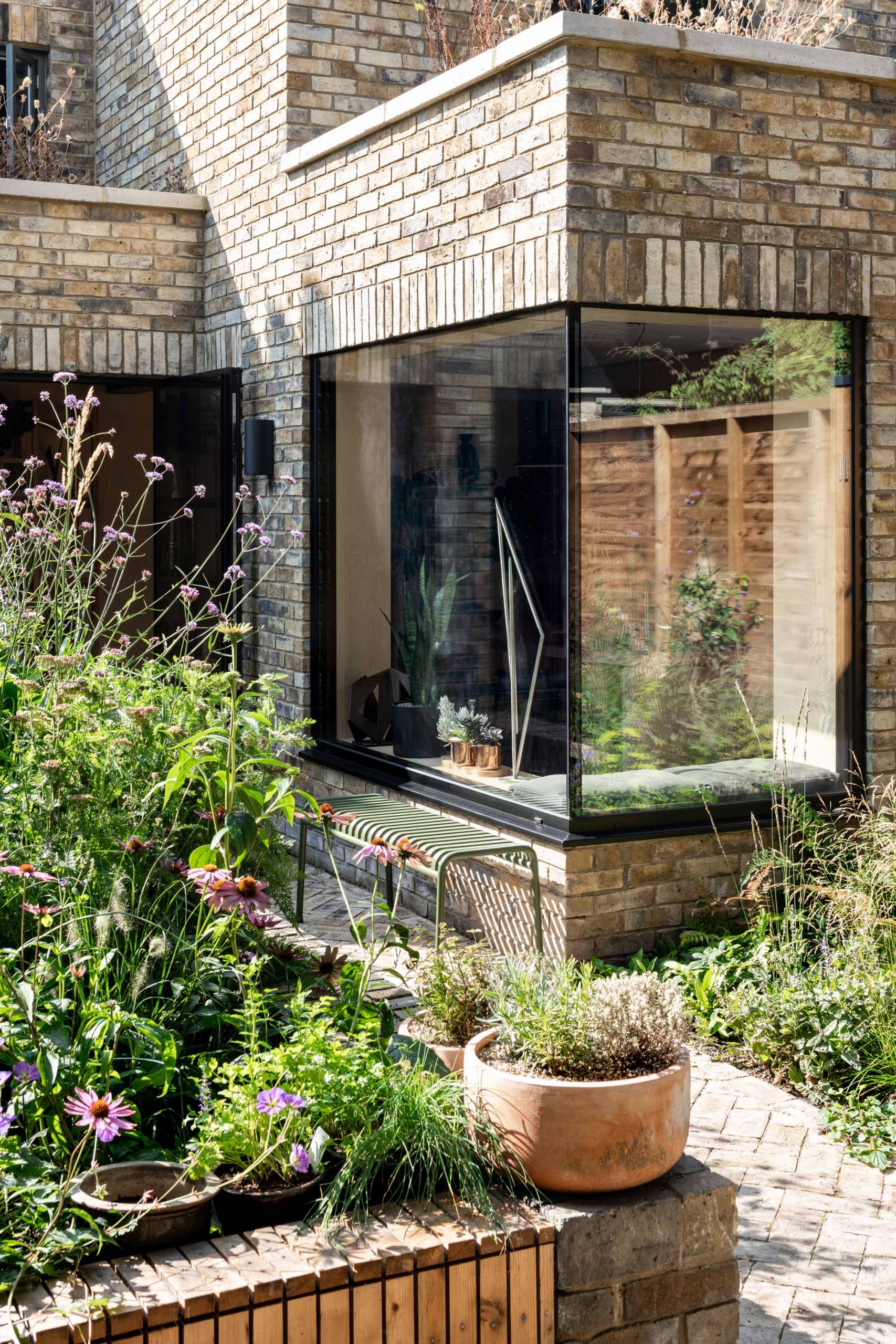
In this article, our director George interviews our Hawthorn House clients, Gareth and Richard, to find out more about how they designed the planting for the beautiful garden. The project was recently recognised as Transformation of the Year at the British Homes Awards and was celebrated for the success of the connection between home and garden.
Where did you take your inspiration from when you designed the planting for your garden?
We were initially very inspired by Nigel Dunnett’s planting at the Barbican, but when we were planning the garden, in lockdown, we were very inspired by Piet Oudolf’s ‘prairie’ planting and schemes. The idea was to use more self-sustaining, drought tolerant plants, but it didn’t quite work out like that. Oudolf uses a lot of ‘spikes and plates’ in terms of flowers, and he mixes tall fast-growing plants with underplanting lower-lying leaves. His attitude is that ‘a weed is only a weed until you know its name’ and then it becomes a plant. We’ve had quite a few unexpected and unplanned plants such as umbellifers, scarlet pimpernel, St Peter’s wort, and opium poppies, that we are very happy to keep, and they are happy to stay. Eventually we want the plants to find an equilibrium- if they are happy to grow there then we are happy for them to stay.
How did you arrange the planting in the beds?
The planting is all about knowing how the light behaves. We had the benefit of knowing the garden and how the light moves through it during the day. The planting was arranged in a diagonal across the garden, to respond to the angle of the sun and shade. We planted shade-loving plants, mainly ferns, nearer the house, and taller flowering ‘spikes’ away from the house to not fully block the view. In the main, raised bed we first planted some ‘anchor’ shrubs that would be the focus of the bed. We planted a sambucus (elder), a cornus (dogwood), and cotinus (smoke tree), close together. These shrubs each have very pleasing leaves in diverse shapes and colours ranging from light green to burgundy, and in the case of the sambucus it grows very quickly. The far end of this bed gets sun most of the day and so we put plants that appreciate that there.
Garden design always seems to have an element of trial and error to it, what did you learn with your garden?
A truism of gardens is that they are never finished and although we had the advantage of knowing the garden before we re-planted it, there is still a lot of trial and error involved. The main raised bed has been fairly successful, but the beds on the left and along the back wall have been less successful. We thought the back right bed would receive more light than it does, so we have now replaced the plants with ferns and shade-loving plants. It might also be an issue to do with the soil- there’s a spot to the left of the back gate where nothing will grow, but we’re not giving up- we just haven’t found the right plant yet. We really wanted to grow Kniphofia (red hot pokers), but Oudolf warns that they are unreliable, and he was right.
We have also found that Chunky, our dog, likes to garden- he systematically ‘waters’ some of the accessible plants on the edge of the borders until they become ex-plants! And we’ve had to put low trellis around the beds to stop him trampling over everything, which isn’t ideal but a necessary compromise if it means that the plants survive.
Could you tell us some of the plants that you have used and why?
We tried to keep it simple, but of course we got carried away. We love ferns and have tried to incorporate quite a few different types with different leaf shapes, and these are mainly evergreen to keep some interest in the winter, such as Asplenium scolopendrium (Hearts’ Tongue fern), Cyrtomium Fortunei, (Fortune’s Holly Fern) and Dryopteris (Wood Ferns). Brunnera Jack Frost has large heart-shaped, variegated leaves that form low clumps under the shrubs in the raised bed. Verbina bonariensis which self-seeds everywhere, Achillia Credo, Echinacia Magnus, Cephalaria Gigantea which looks like a giant scabius but isn’t, Geranium Rozanne, Salvias, all loved by insects.
The back left bed is dominated by Euphorbia characias subsp. wulfenii ‘Lambrook Gold’ which grows large and flowers in January. Lots of ornamental grasses such as Calamagrostis X acutiflora ‘Karl Foerster’, Deschampsia Cespitosa ‘Goldtau’, Anemanthele lessoniana ‘pheasant’s tail grass’, and Molinia caerulea subsp. caerulea ‘Moorhexe’. Grasses give movement to the garden and their flower spikes can be left all winter, giving the garden some architectural structure and interest over the cold months, and we cut them back in March.
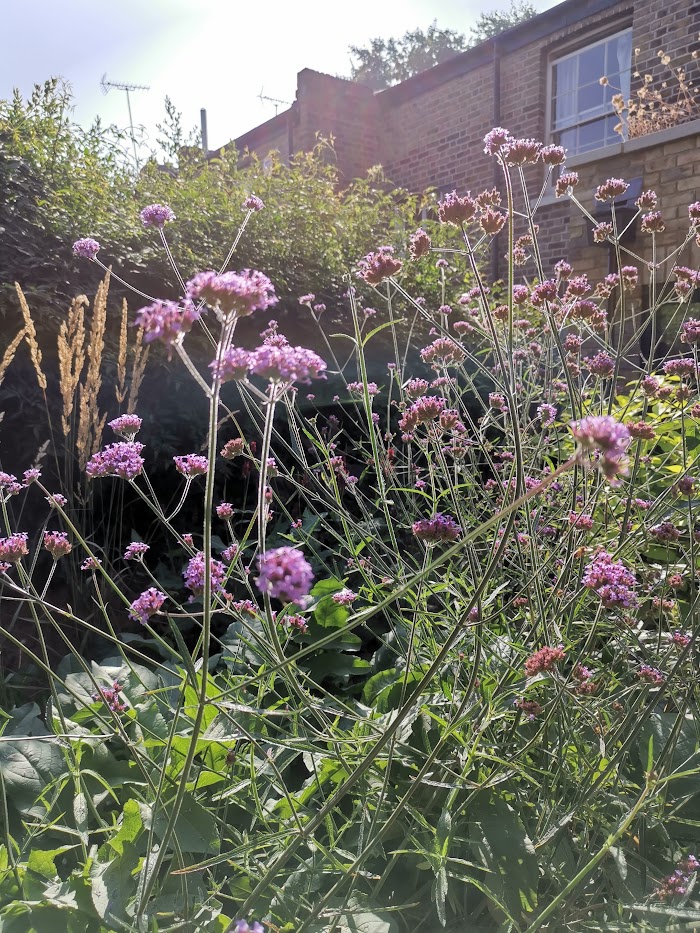
Verbina Bonariensis
Two of the only remaining plants from before the redesign were a climbing jasmine (Trachelospermum jasminoides) and a climbing hydrangea (Seemannii) and we’ve planted more of these around the peripheral walls so that in a few years all the timber and brick walls will be evergreen.
The planting of the garden compliments the wildflowers on the flat roofs -spikes and plates- and we have tried to keep a lot of the planting similar across the garden for simplicity, but it doesn’t always work out that way. The wildflower roofs require more maintenance than a sedum roof, but the diversity of plant is more interesting and the benefits to wildlife are better.
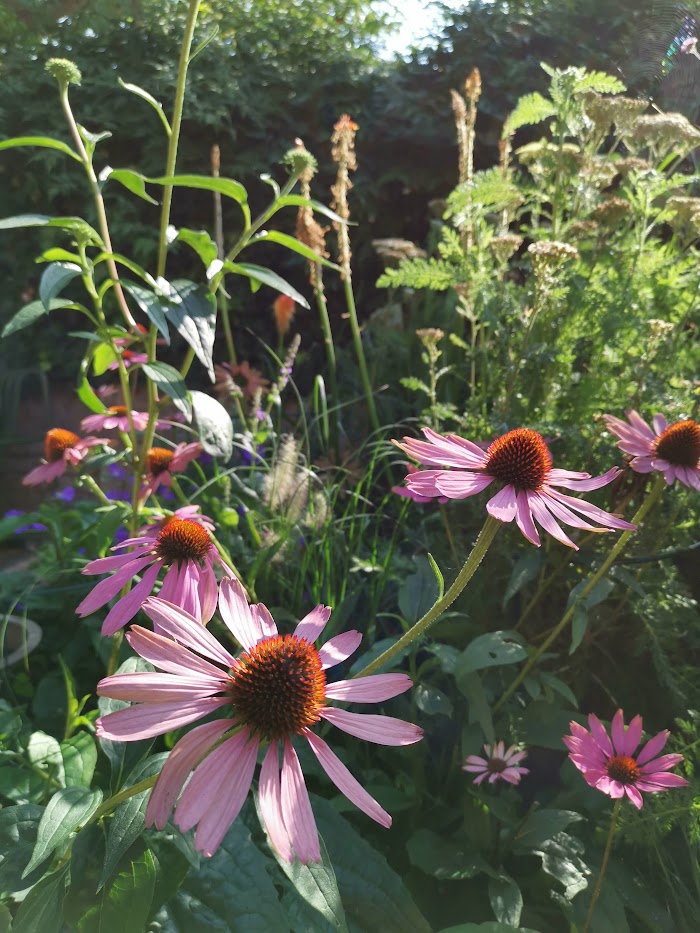
Echinacia Magnus
The raised bed must be a real haven for wildlife.
We love how many insects there are in the garden, and bees are an especially hot topic in our household. However, we have noticed less insects than a few years back which is very concerning. Comparative plants we had a few years ago were swarming with bees, but there are fewer now.
The view of the garden from the interior was fundamental to your design brief. We loved how you asked for the patio to be away from the house so that you see the planting. How have you responded to that with your layout for the planting?
As well as planting diagonally to respond to the sun, the planting also works in layers across the planter, so that when you are viewing from the window seat or from the back of the garden you can see layers of different planting. Taller plants are set further away from the picture window and lower ferns closer so you can appreciate all the plants in a layered view from inside. We haven’t quite got that working how we want to from the side view from the kitchen but will work on that over time.
Tell us a little more about the pond?
There are nine shubunkins in the pond, a type of goldfish with varied colours and patterns. They tend to stay near the surface a lot, so they are very visible. You can feed them from the window seat from the inside. It’s a nice thing to be able to do on a rainy day. We added willow moss to the pond which forms a green bed across the base and oxygenates the water.
The plants around the pond, ferns and maiden hair vine, are low growing and have been used to soften the edge of the pond and blur the edge of the window cill.
Some friends of ours who are product designers brought back some wild black flowering grass from Sweden and offered us some for the pond. They also made a bespoke black porcelain pot designed perfectly for the depth of our pond, to house the grass, which now sits happily in the corner of the pond.
The sound of running water from the pond right next to the picture window is also very calming and acts as a baffle from any surrounding noise.
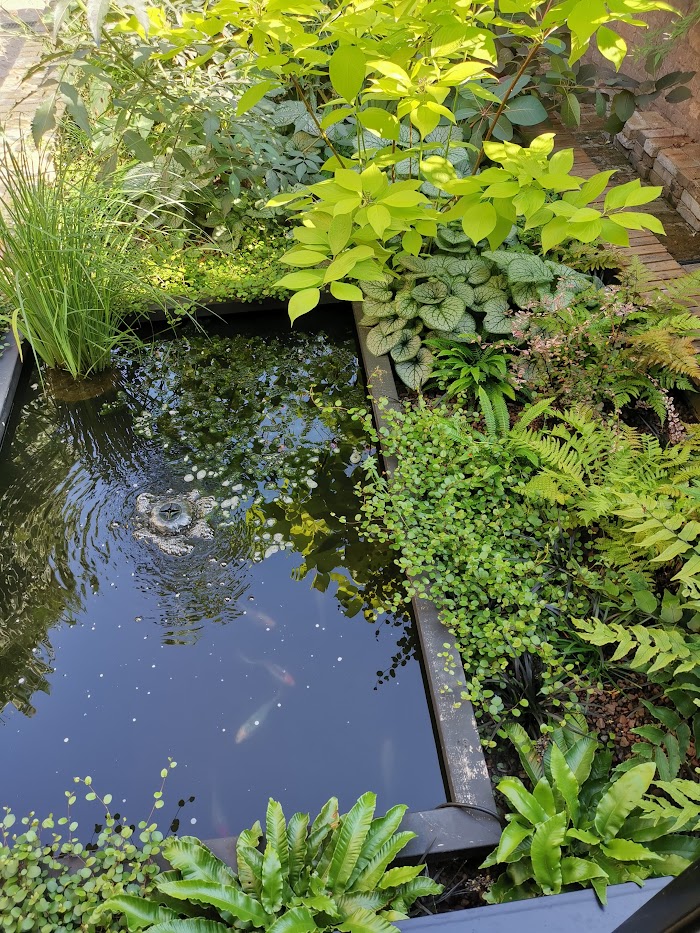
Low growing plants around the pond
What’s the difference to how you use the house now compared to before?
Before, the house felt smaller. It was more contained with defined rooms and spaces. Now it is more free-flowing and the spaces blur into one another. We also have better views of everything because its more open.
It’s not that much bigger compared to before, but it feels a lot bigger. We spend a lot of time in the kitchen and tend to eat there more now as well. We use the outdoors more because we are in closer contact with it. We now go out into the garden several times a day, even when the weather isn’t beautiful, because it is so nice out there.
What works about having the patio away from the house is you are inclined to use the whole outside space. You move through the garden to reach it and then you can look back to appreciate the whole house.
What are your favourite parts of the garden?
The view from inside over the pond and through the planting in the raised bed is a particular favourite. The area is very private, and quite small and intimate, and is beginning to look very natural, like looking into a tiny woodland.
It’s also lovely to take a couple of cushions and sit on the brick wall beside the pond with your back against the house to read a book.
One of the successes of the design is that the raised bed is extremely wild with its planting, but is also ‘contained’ architecturally by the boundary and the contrast between wild and contained works really well.
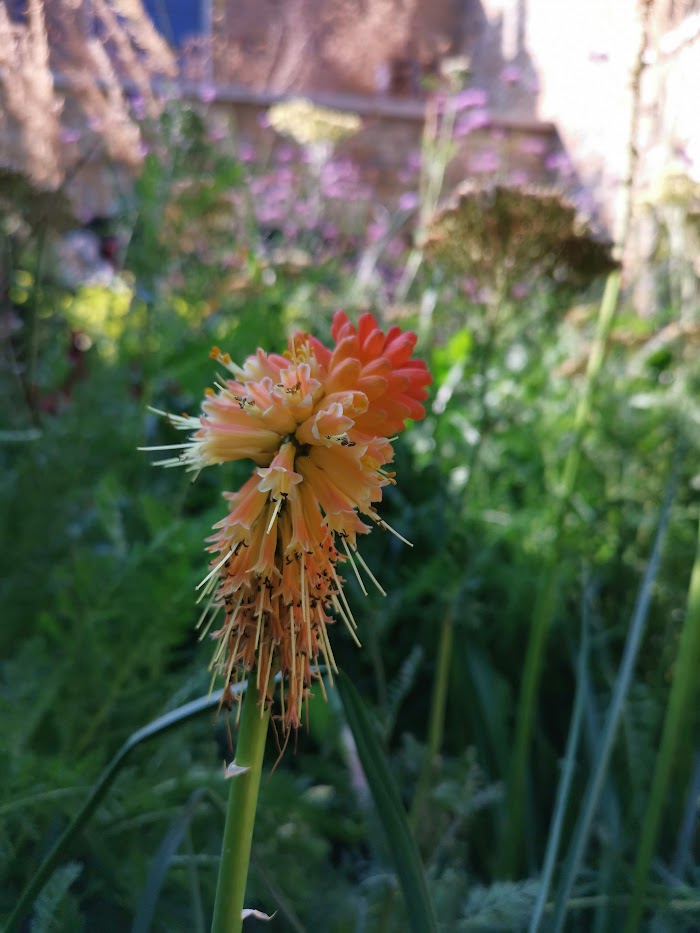
Red Hot Poker
And the house?
Our favourite space is the kitchen. The whole ground floor is more pleasurable than before because you can move through it all so easily.
From the Eames reclining chair you can see the whole ground floor, to one side the lounge, ahead of you the kitchen and to the other side the garden. This is also a great location to read or snooze!
The internal glazed corner is brilliant because It makes the internal space feel much, much bigger.
We were really excited to extend the garden onto the building by including the wildflower roof on the extension. Would you recommend wildflower roofs to others?
The wildflower planting on the roof really helps to soften the hard edges and lines of the building. The contrast between wild and contained also works well here. At a certain time of day, the wildflowers cast shadows against the white sides around the roof window in the kitchen below.
Guests have said they love in the spare room, opening the curtains in the morning and seeing the wildflowers. They said it’s a very peaceful and romantic view.
The wildflower roof is more work than a sedum roof in terms of care, but it’s worth it as it gives you more variety and texture. The plants are finding their own balance and you have to let them do their own thing, which is often a bit messy and unpredictable. We would definitely recommend installing one, but not if you want a very manicured and tidy roof garden.
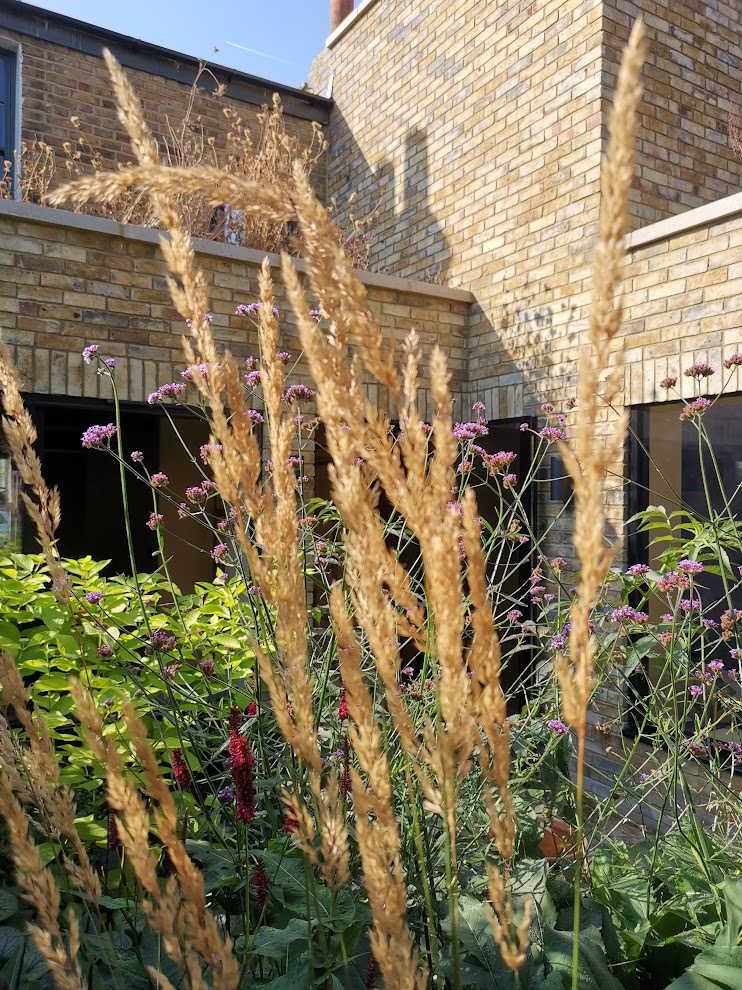
Calamagrostis X Acutiflora ‘Karl Foerster’
Have there been any surprises that your garden has thrown up, that you didn’t expect?
We are surprised at how big some of the planting has grown. Particularly after a poor start to 2021 weather wise, we thought they wouldn’t grow.
We have also had things like poppies and nettles grow throughout the year, without having planted any seeds.
I think one of the main successes of this project, is the interconnection between inside and out.
What is it like to live in from this perspective?
You are aware of the garden all the time because you see it all the time, which is terrific. Really you are just aware of the outside when you are inside in a way we weren’t before we did the work.
Bringing the garden up to the window is also really good. I love being able to sit in the window whatever the weather. When it snowed this year, we were able to sit inside and watch the snow falling. Because of the window seat there is much more engagement with the weather outside.
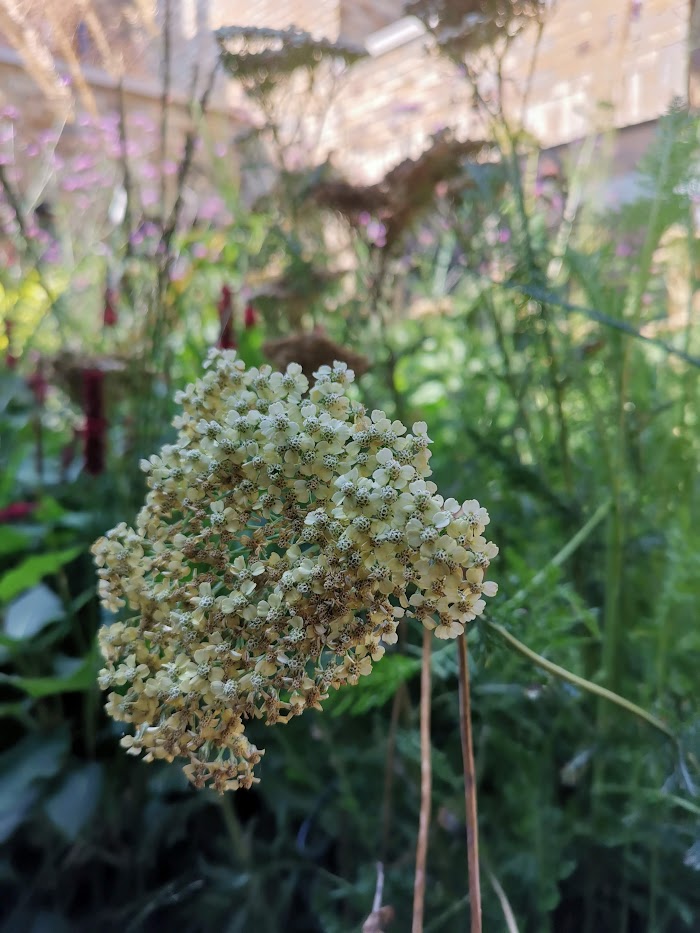
Achillia Credo

Verbina Bonariensis
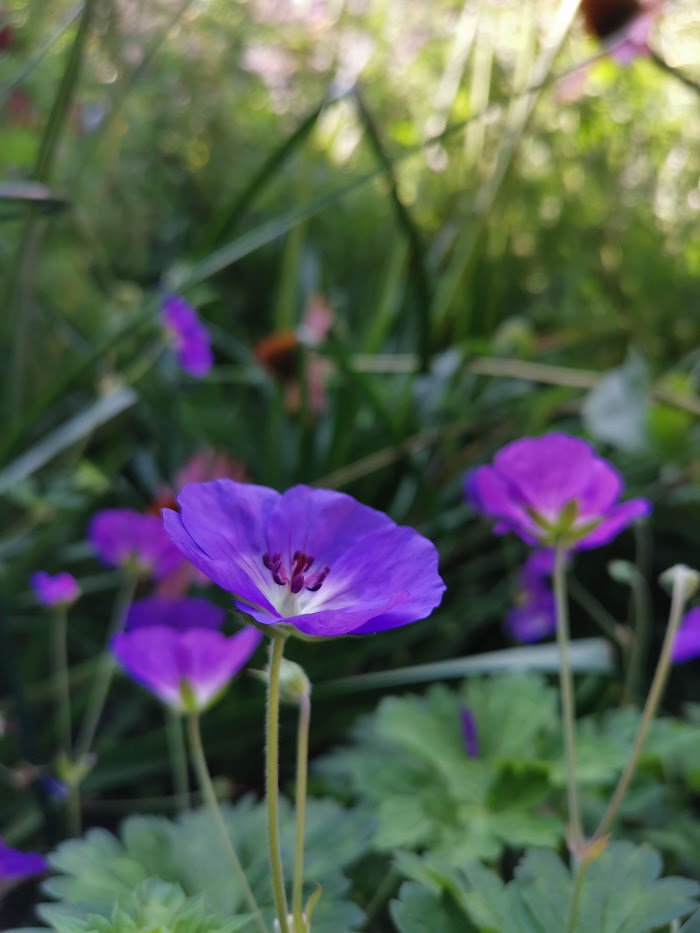
Geranium Rozanne